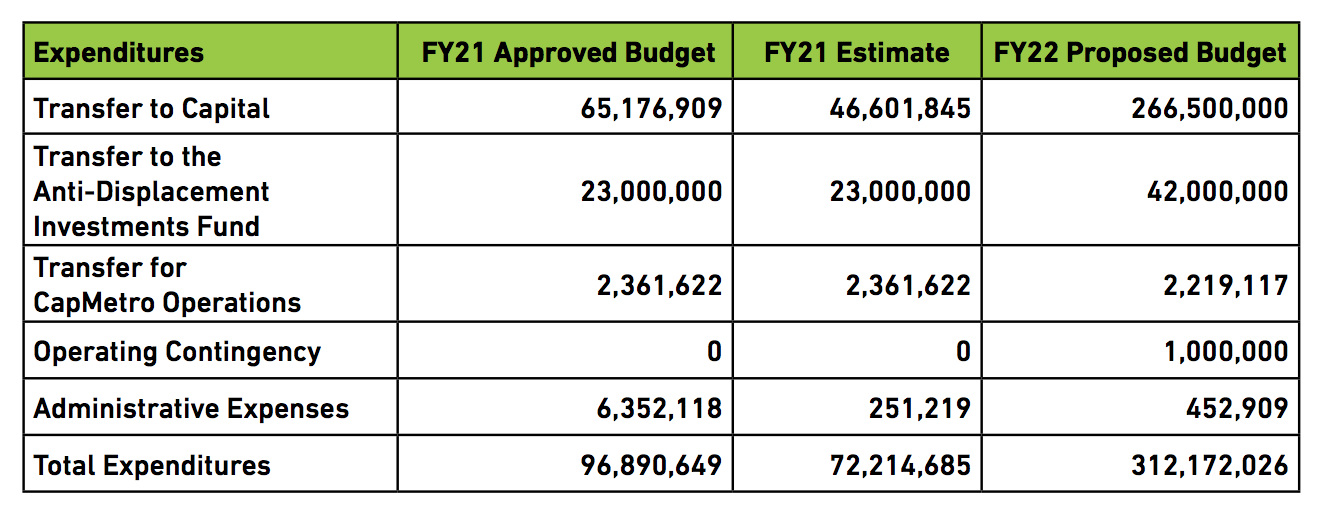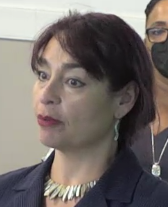Includes first full-year funding for two new light-rail lines and enhanced bus service
The board that governs the implementation of Project Connect has approved its first ever full-year budget of $312.8 million, setting aside funds for design work, right-of-way acquisition, community engagement, and anti-displacement efforts.
Austin Transit Partnership was incorporated by the City of Austin and Capital Metro (CapMetro) last December after voters approved Proposition A, a ballot measure authorizing a new transit tax. The tax of 8.75 cents per $100 property value provides a permanent source of revenue to build and operate a light rail system and expand CapMetro’s bus network.
In the tax election held November 3, 2020, Proposition A passed with 57.9 percent of the votes, overcoming mixed opposition from both left and right. While most elected Democrats in Austin supported Prop A, a progressive minority argued that a new property tax would worsen the city’s ongoing affordability crisis, while potential benefits of the plan were a decade away.

ATP’s board includes Mayor Steve Adler; CapMetro Board Member Eric Stratton, Huston-Tillotson University President Colette Pierce Burnette; finance specialist Tony Elkins; and architect Veronica Castro de Barrera, who serves as chair. Assistant City Manager for Mobility Gina Fiandaca is an ex-officio non-voting member of the board.
ATP will design, finance, and build the new light rail lines, while CapMetro will operate them. ATP and CapMetro share the same chief executive, Randy Clarke; the other executive staff of the two organizations do not overlap.

At a meeting Wednesday, the ATP board unanimously approved the $312.8 million budget, which is more than triple the estimated $72.2 million that ATP spent in its truncated first year of operation. Half of the new budget comes from the Prop A property tax, 43 percent comes from unspent funds from the last fiscal year, and 7 percent comes from CapMetro’s annual contribution, according to a budget presentation by ATP Budget Director Diana Siler.
The bulk of the funds, 86 percent, will go toward capital projects, including $93 million for the Orange Line, $83 million for the Blue Line, and $42 million for enhanced MetroRapid bus service. $10 million is slated for design and construction of new Park & Ride locations.
Thirteen percent of the budget, or $42 million, will be transferred to the City of Austin for “transit-supportive, anti-displacement investments.” The city will use those funds to acquire real estate for housing developments and for “other anti-displacement strategies,” according to the ATP budget. In the current year Austin already received $23 million from ATP for anti-displacement, none of which has been spent, so it will have $65 million at its disposal next year.

ATP’s operating costs will also grow in the new year as it doubles its team from 42.5 budgeted FTEs to 84.5 FTEs. So far 37 positions have been filled. The additional staff will be involved in community engagement, legal and financial services, procurement, architecture, and urban design. Salaries and benefits across all capital projects will cost $13.3 million, operating contracts will cost $8.2 million, and leases will cost $6.3 million, according to Siler’s presentation to the board. However, administrative expenses appear low in the new budget (0.1 percent or $453,000) because staff and consultants are allocated either directly to capital projects that they work on or are costed indirectly to the various capital projects through a cost allocation plan.

The board made only two changes to the proposed budget first discussed in August. One, at the recommendation of ATP staff, it added $600,000 to set up a mobile experience center designed to help CapMetro raise awareness about its plans and receive input from the public. “Think of it as a museum on wheels,” Siler said. Secondly, the board increased the budgeted revenue from the City of Austin by $1.2 million, a result of the city increasing its property tax rate by 4.7 percent rather than 3.5 percent as previously anticipated.
FY 2022 investments
The costliest elements of Project Connect are the new Orange and Blue light-rail lines, including a downtown subway tunnel needed to connect these lines and allow them to serve the downtown area without causing gridlock.
The FY22 budget includes funding for design and engineering, environmental compliance, project controls, utilities and surveys, and right-of-way acquisition for the Orange and Blue lines. The real estate component involves hiring a consultant to advise on buying properties, surveying, appraisal, and “funds for potential early acquisition of parcels.”
The Orange Line will run north-south along North Lamar Boulevard and South Congress Avenue, while the Blue Line will run from the airport to the Central Business District and then join the Blue Line at Republic Square to run north up North Lamar Boulevard, terminating at the North Lamar Transit Center.
For now, those two lines are the priority; construction on the proposed Green Line connecting Manor, Pleasant Valley, and downtown isn’t expected to begin for another decade. However, the FY22 budget includes $13.5 million for one improvement to the existing Red Line: a new station at McKalla Place, adjacent to Q2 Stadium, where Austin FC plays its home games.
The station overall will cost $24 million, of which Austin FC will pay $3.6 million under a deal inked in May. Preliminary engineering and the environmental review for that station is already underway. Design is anticipated to be complete by the end of the calendar year with groundbreaking occurring in early 2022, according to the budget.
 Trust indicators: Bulldog reporter Daniel Van Oudenaren is a journalist with 12 years experience in local, state, and international reporting.
Trust indicators: Bulldog reporter Daniel Van Oudenaren is a journalist with 12 years experience in local, state, and international reporting.
Links to related documents:
Austin Transit Partnership Proposed Budget, August 2021 (46 pages)
Project Connect System Plan, Initial Investment, adopted June 10, 2020 (graphic)
Links to related Bulldog coverage:
Transit tax draws attack from the left, October 2, 2020







